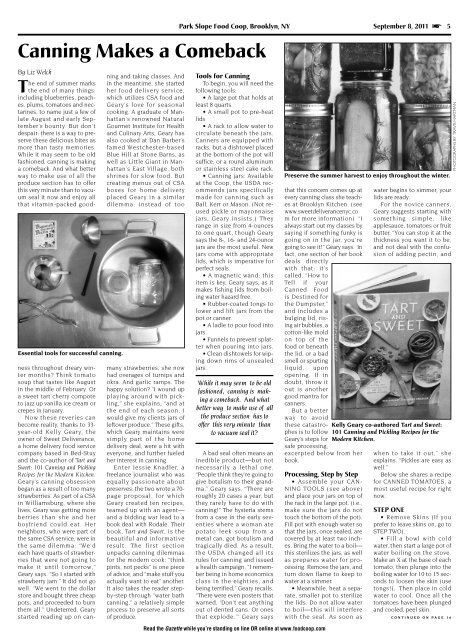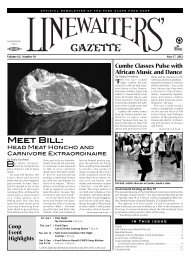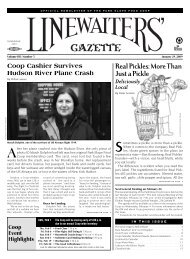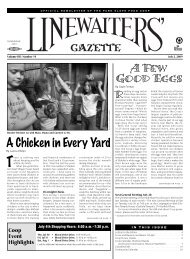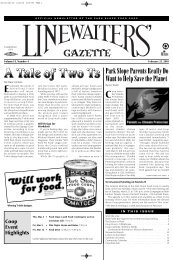September 8th, 2011 : Volume FF, Number 18 - Park Slope Food Coop
September 8th, 2011 : Volume FF, Number 18 - Park Slope Food Coop
September 8th, 2011 : Volume FF, Number 18 - Park Slope Food Coop
You also want an ePaper? Increase the reach of your titles
YUMPU automatically turns print PDFs into web optimized ePapers that Google loves.
11-09-08.pp1-16.gazette_Layout 1 9/7/11 7:27 PM Page 5<br />
Canning Makes a Comeback<br />
Essential tools for successful canning.<br />
By Liz Welch<br />
The end of summer marks<br />
the end of many things:<br />
including blueberries, peaches,<br />
plums, tomatoes and nectarines,<br />
to name just a few of<br />
late August and early <strong>September</strong>’s<br />
bounty. But don’t<br />
despair: there is a way to preserve<br />
these delicious bites as<br />
more than tasty memories.<br />
While it may seem to be old<br />
fashioned, canning is making<br />
a comeback. And what better<br />
way to make use of all the<br />
produce section has to offer<br />
this very minute than to vacuum<br />
seal it now and enjoy all<br />
that vitamin-packed goodness<br />
throughout dreary winter<br />
months Think tomato<br />
soup that tastes like August<br />
in the middle of February. Or<br />
a sweet tart cherry compote<br />
to jazz up vanilla ice cream or<br />
crepes in January.<br />
Now these reveries can<br />
become reality, thanks to 33-<br />
year-old Kelly Geary, the<br />
owner of Sweet Deliverance,<br />
a home delivery food service<br />
company based in Bed-Stuy<br />
and the co-author of Tart and<br />
Sweet: 101 Canning and Pickling<br />
Recipes for the Modern Kitchen.<br />
Geary’s canning obsession<br />
began as a result of too many<br />
strawberries. As part of a CSA<br />
in Williamsburg, where she<br />
lives, Geary was getting more<br />
berries than she and her<br />
boyfriend could eat. Her<br />
neighbors, who were part of<br />
the same CSA service, were in<br />
the same dilemma: “We’d<br />
each have quarts of strawberries<br />
that were not going to<br />
make it until tomorrow,”<br />
Geary says. “So I started with<br />
strawberry jam.” It did not go<br />
well. “We went to the dollar<br />
store and bought three cheap<br />
pots, and proceeded to burn<br />
them all.” Undeterred, Geary<br />
started reading up on canning<br />
and taking classes. And<br />
in the meantime, she started<br />
her food delivery service,<br />
which utilizes CSA food and<br />
Geary’s love for seasonal<br />
cooking. A graduate of Manhattan’s<br />
renowned Natural<br />
Gourmet Institute for Health<br />
and Culinary Arts, Geary has<br />
also cooked at Dan Barber’s<br />
famed Westchester-based<br />
Blue Hill at Stone Barns, as<br />
well as Little Giant in Manhattan’s<br />
East Village, both<br />
shrines for slow food. But<br />
creating menus out of CSA<br />
boxes for home delivery<br />
placed Geary in a similar<br />
dilemma: instead of too<br />
many strawberries, she now<br />
had overages of turnips and<br />
okra. And garlic ramps. The<br />
happy solution “I wound up<br />
playing around with pickling,”<br />
she explains, “and at<br />
the end of each season, I<br />
would give my clients jars of<br />
leftover produce.” These gifts,<br />
which Geary maintains were<br />
simply part of the home<br />
delivery deal, were a hit with<br />
everyone, and further fueled<br />
her interest in canning.<br />
Enter Jessie Knadler, a<br />
freelance journalist who was<br />
equally passionate about<br />
preserves: the two wrote a 70-<br />
page proposal, for which<br />
Geary created ten recipes,<br />
teamed up with an agent—<br />
and a bidding war lead to a<br />
book deal with Rodale. Their<br />
book, Tart and Sweet, is the<br />
beautiful and informative<br />
result. The first section<br />
unpacks canning dilemmas<br />
for the modern cook: “think<br />
pints, not pecks” is one piece<br />
of advice, and “make stuff you<br />
actually want to eat” another.<br />
It also takes the reader stepby-step<br />
through “water bath<br />
canning,” a relatively simple<br />
process to preserve all sorts<br />
of produce.<br />
<strong>Park</strong> <strong>Slope</strong> <strong>Food</strong> <strong>Coop</strong>, Brooklyn, NY <strong>September</strong> 8, <strong>2011</strong> 5<br />
Tools for Canning<br />
To begin, you will need the<br />
following tools:<br />
• A large pot that holds at<br />
least 8 quarts.<br />
• A small pot to pre-heat<br />
lids<br />
• A rack to allow water to<br />
circulate beneath the jars.<br />
Canners are equipped with<br />
racks, but a dishtowel placed<br />
at the bottom of the pot will<br />
suffice, or a round aluminum<br />
or stainless steel cake rack.<br />
• Canning jars: Available<br />
at the <strong>Coop</strong>, the USDA recommends<br />
jars specifically<br />
made for canning such as<br />
Ball, Kerr or Mason. (Not reused<br />
pickle or mayonnaise<br />
jars, Geary insists.) They<br />
range in size from 4-ounces<br />
to one quart, though Geary<br />
says the 8-, 16- and 24-ounce<br />
jars are the most useful. New<br />
jars come with appropriate<br />
lids, which is imperative for<br />
perfect seals.<br />
• A magnetic wand: this<br />
item is key, Geary says, as it<br />
makes fishing lids from boiling<br />
water hazard free.<br />
• Rubber-coated tongs to<br />
lower and lift jars from the<br />
pot or canner.<br />
• A ladle to pour food into<br />
jars.<br />
• Funnels to prevent splatter<br />
when pouring into jars.<br />
• Clean dishtowels for wiping<br />
down rims of unsealed<br />
jars.<br />
While it may seem to be old<br />
fashioned, canning is making<br />
a comeback. And what<br />
better way to make use of all<br />
the produce section has to<br />
offer this very minute than<br />
to vacuum seal it<br />
A bad seal often means an<br />
inedible product—but not<br />
necessarily a lethal one.<br />
“People think they’re going to<br />
give botulism to their grandma,”<br />
Geary says. “There are<br />
roughly 20 cases a year, but<br />
they rarely have to do with<br />
canning!” The hysteria stems<br />
from a case in the early seventies<br />
where a woman ate<br />
potato leek soup from a<br />
metal can, got botulism and<br />
tragically died. As a result,<br />
the USDA changed all its<br />
rules for canning and issued<br />
a health campaign. “I remember<br />
being in home economics<br />
class in the eighties, and<br />
being terrified,” Geary recalls.<br />
“There were even posters that<br />
warned, ‘Don’t eat anything<br />
out of dented cans. Or ones<br />
that explode.’” Geary says<br />
that this concern comes up at<br />
every canning class she teaches<br />
at Brooklyn Kitchen. (see<br />
www.sweetdeliverancenyc.co<br />
m for more information) “I<br />
always start out my classes by<br />
saying if something funky is<br />
going on in the jar, you’re<br />
going to see it!” Geary says. In<br />
fact, one section of her book<br />
deals directly<br />
with that: it’s<br />
called, “How to<br />
Tell if your<br />
Canned <strong>Food</strong><br />
is Destined for<br />
the Dumpster,”<br />
and includes a<br />
bulging lid, rising<br />
air bubbles, a<br />
cotton-like mold<br />
on top of the<br />
food or beneath<br />
the lid, or a bad<br />
smell or spurting<br />
liquid, upon<br />
opening. If in<br />
doubt, throw it<br />
out is another<br />
good mantra for<br />
canners.<br />
But a better<br />
way to avoid<br />
these catastrophes<br />
is to follow<br />
Geary’s steps for<br />
safe processing,<br />
excerpted below from her<br />
book.<br />
Processing, Step by Step<br />
• Assemble your CAN-<br />
NING TOOLS (see above)<br />
and place your jars on top of<br />
the rack in the large pot. (i.e.,<br />
make sure the jars do not<br />
touch the bottom of the pot).<br />
Fill pot with enough water so<br />
that the jars, once sealed, are<br />
covered by at least two inches.<br />
Bring the water to a boil—<br />
this sterilizes the jars, as well<br />
as prepares water for processing.<br />
Remove the jars, and<br />
turn down flame to keep to<br />
water at a simmer.<br />
• Meanwhile, heat a separate,<br />
smaller pot to sterilize<br />
the lids. Do not allow water<br />
to boil—this will interfere<br />
with the seal. As soon as<br />
Read the Gazette while you’re standing on line OR online at www.foodcoop.com<br />
Preserve the summer harvest to enjoy throughout the winter.<br />
water begins to simmer, your<br />
lids are ready.<br />
For the novice canners,<br />
Geary suggests starting with<br />
something simple, like<br />
applesauce, tomatoes or fruit<br />
butter. “You can stop it at the<br />
thickness you want it to be,<br />
and not deal with the confusion<br />
of adding pectin, and<br />
Kelly Geary co-authored Tart and Sweet:<br />
101 Canning and Pickling Recipes for the<br />
Modern Kitchen.<br />
when to take it out,” she<br />
explains. “Pickles are easy as<br />
well.”<br />
Below she shares a recipe<br />
for CANNED TOMATOES, a<br />
most useful recipe for right<br />
now.<br />
STEP ONE<br />
• Remove Skins (If you<br />
prefer to leave skins on, go to<br />
STEP TWO).<br />
• Fill a bowl with cold<br />
water, then start a large pot of<br />
water boiling on the stove.<br />
Make an X at the base of each<br />
tomato, then plunge into the<br />
boiling water for 10 to 15 seconds<br />
to loosen the skin (use<br />
tongs!). Then place in cold<br />
water to cool. Once all the<br />
tomatoes have been plunged<br />
and cooled, peel skin.<br />
CONTINUED ON PAGE 16<br />
PHOTOGRAPHS BY TRAVIS HARTMAN


